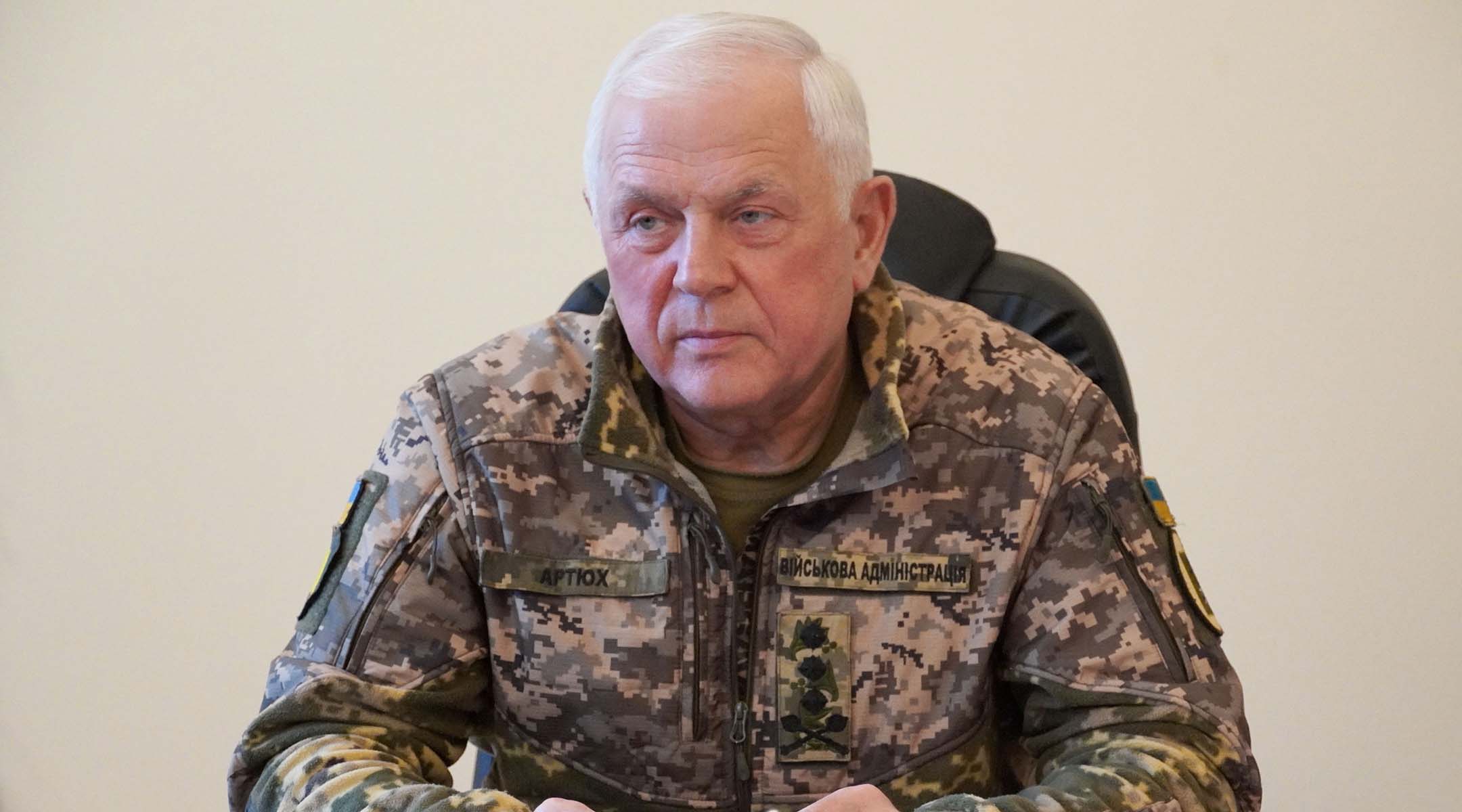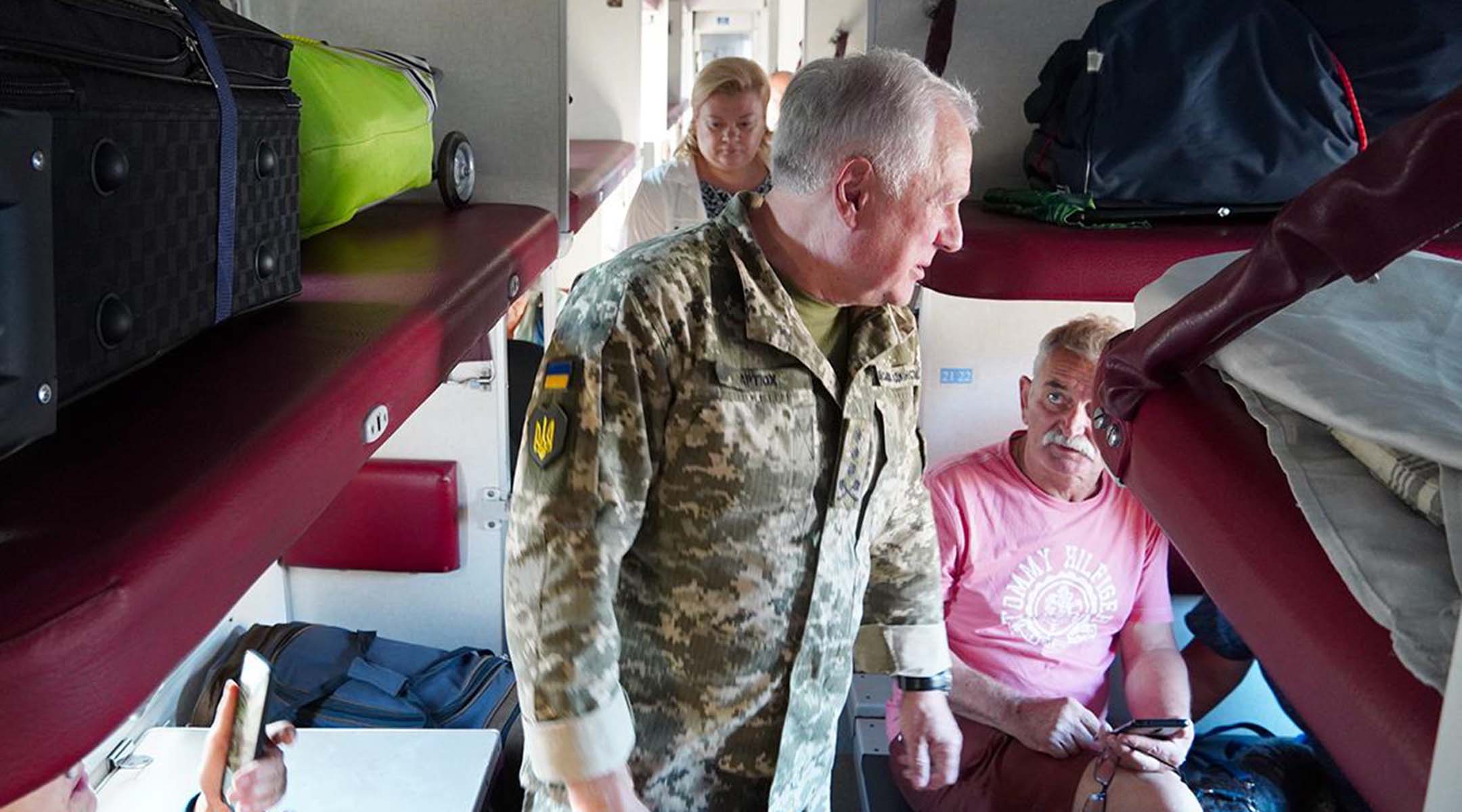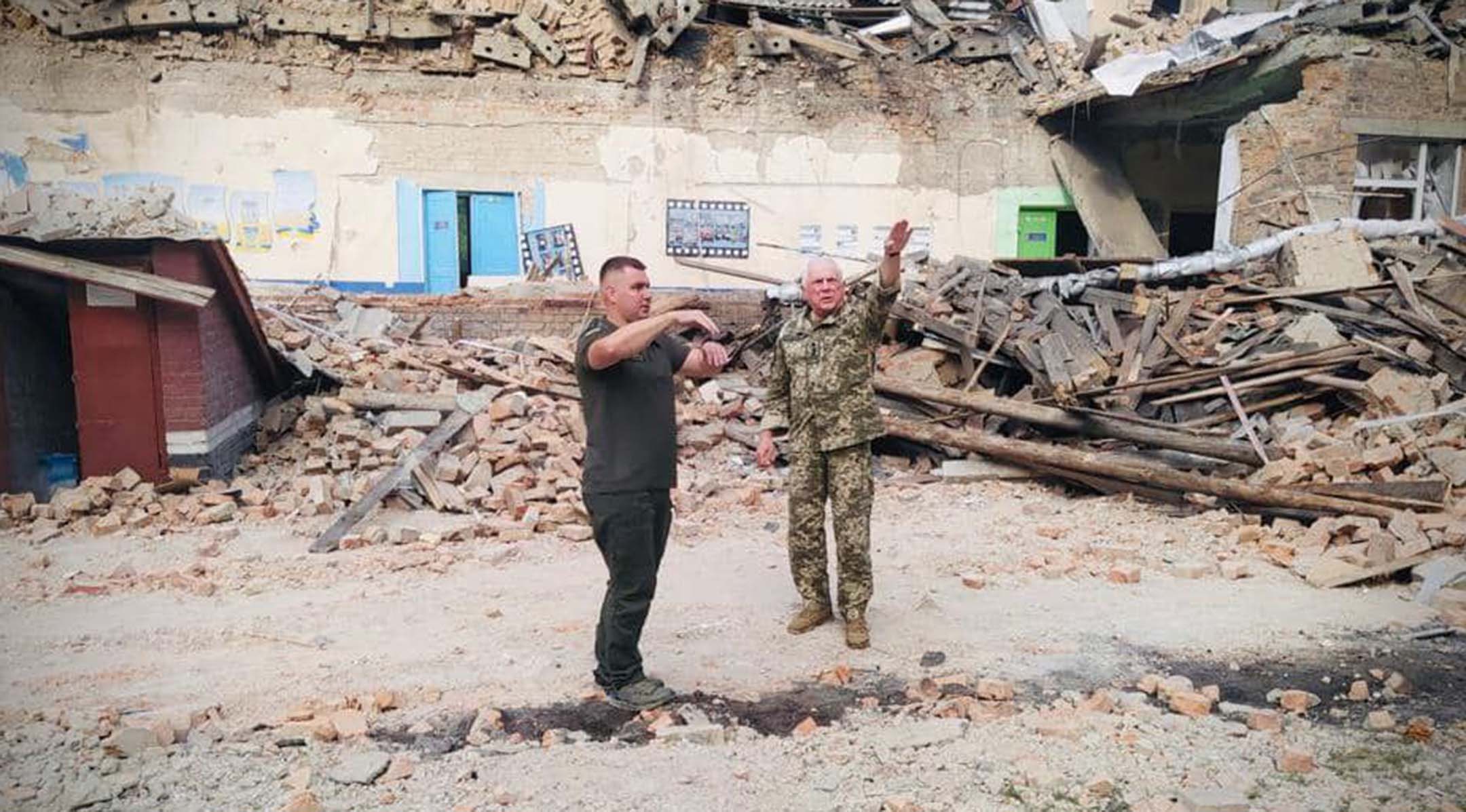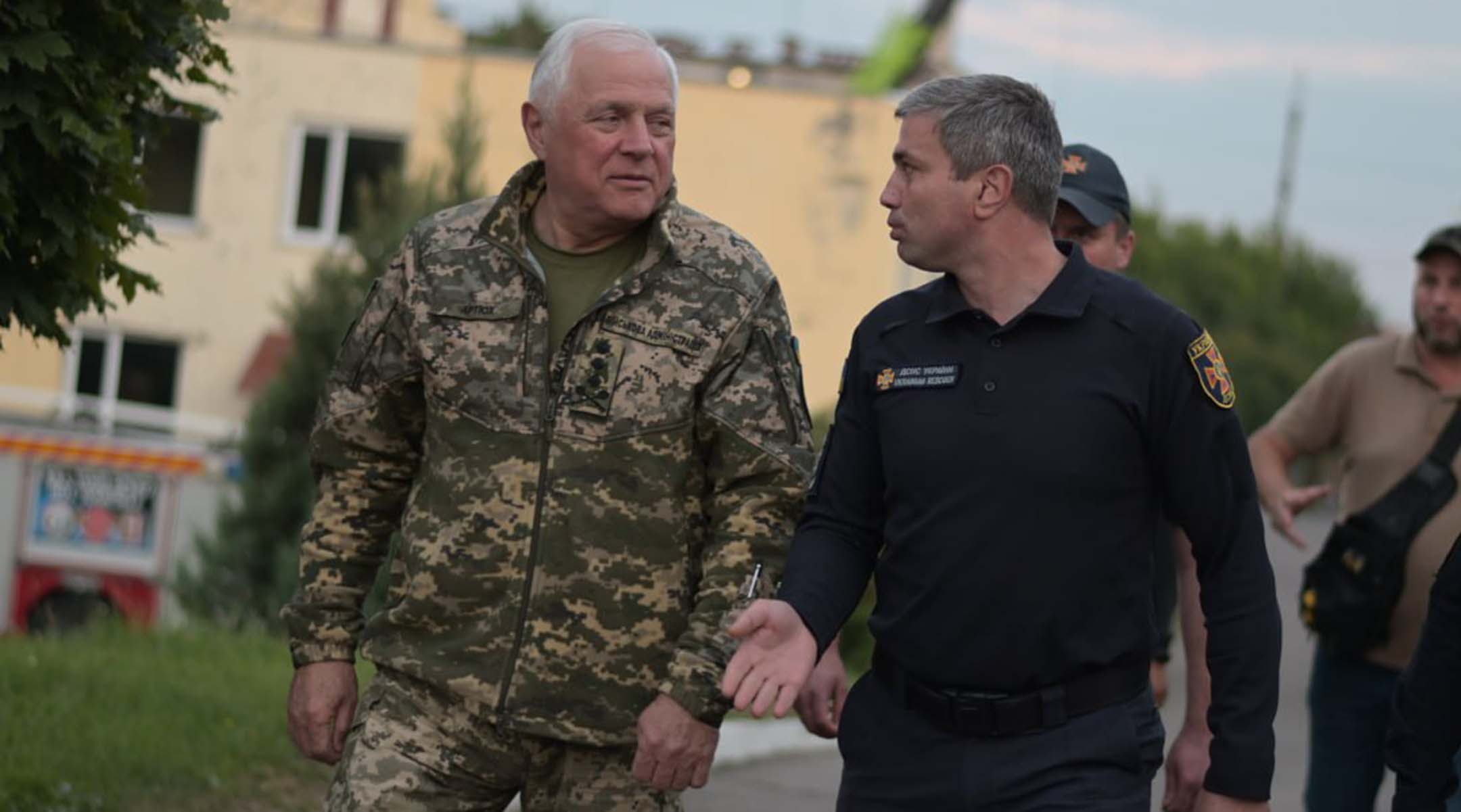The frontline region, which has more than 560 km of border with Russia, is shelled daily with all the heavy weapons available to the enemy - artillery, mortars, cannons, tanks, MLRS. More than a hundred explosions are recorded daily in the border communities of Sumy region due to Russian shelling. People are dying: in the last two months alone, almost 70 victims, including four children. Almost eight dozen are wounded. Attacks by enemy subversive groups have also intensified: they enter, destroy, blow up, and kill. This keeps both civilians and military on their toes.
How Sumy region is living in the second year of a full-scale war with Russia - in an interview with the head of the Sumy Regional Military Administration (RMA), Lieutenant General Volodymyr Artyukh.

SIX COMMUNITIES SUFFER THE MOST FROM SHELLING
- The first thing I wanted to ask is about the communities where the situation in Sumy region is the most difficult due to constant Russian shelling. Recently, we all read about the shelling of the town of Seredyna-Buda with multiple rocket launchers, where civilians were killed, including a 7-year-old child...
- Yes, this is a tragic event that has happened recently in Sumy region. Seredyna-Buda is one of those towns where civilians suffer the most from Russian shelling and where infrastructure, schools, shops are being destroyed... The settlement is located very close to the contact line, so the enemy uses all available heavy weapons - from mortars to MLRS, which were used in this case.
- Are such attacks always unexpected for local residents, or is there any way to escape them?
- Unfortunately, this is the peculiarity of shelling in the 5-km border zone: there is only 10 km between the enemy's weapons and our people. The means are guns, tanks, and drones. In terms of time, people hear the exit, which means that the shell has been launched. In 1-2 seconds, it has already found its victim. No warning system will work here. If there is artillery or mortar fire, meaning there is the first and then the second shell, people still have the opportunity to run to a shelter like a cellar. And if it is a multiple rocket launcher system that covers a large area of the settlement, there is almost no chance of remaining unharmed. That's why we announced voluntary evacuation of the population in the 5-km zone back in the summer.
NOT EVERYONE IS WILLING TO EVACUATE
- Are people leaving, where are they going, what conditions and support are they offered?
- Of course, not everyone wants to leave their homes. We evacuate them within the region. From one or another settlement, we ensure that people are moved to safer places, further from the border into the depths of the region. We, as the RMA, provided the opportunity to move to other regions, with appropriate payments, free transportation and support as IDPs, but there were only a few such people, the vast majority left by private transport.
- So, there are a lot of "leftovers" in the border villages in Sumy region?
- People have expressed a desire to stay in their homes, but we have not and will not leave them alone with their problems. I will say once again that the evacuation from the 5-kilometer zone is exclusively voluntary. Indeed, at the time when we announced the evacuation - and it was July 2023 - there were really few people willing to do so. People argued that they had land, gardens, cattle, etc. Now the harvest has already been harvested, and the shelling has intensified significantly, especially over the past two months, when we have recorded more than 100 arrivals in the region per day. This was not the case in the summer. People see this, and tragedies like the one in Seredyna-Buda on November 28 push people to leave the danger zone.
Over the past two months, four children have been killed in the region, 64 civilians in total, and 79 wounded in Russian shelling.

- Where is the most critical situation in Sumy region due to shelling?
- Over the past three months, the Krasnopilska community has had the most attacks, with more than 409 recorded. Velyka Pysarivka - 209. Bilopillia - 188. Seredyna-Buda - 159. Khotyn community - 148. Yunakivska - 115. These are the communities that suffer the most, they are shelled every day. The means of destruction used by the enemy are artillery, mortars, cannons, tanks, MLRS, and even Shahed-type attack drones, aviation (helicopters) and ballistics. The threat is significant.
- Is it proportional to the outflow of population: are people leaving the most from these communities where Russians are shooting the most?
- Unfortunately, no. For example, the Velykopysarivska community - I would not say that there is a strong outflow of residents from here. There are beautiful villages, people have jobs, land. This keeps them there. However, people's opinions are also affected by the fact that the shelling has intensified, and the actions of sabotage groups have also increased. The enemy enters our territory, makes such attacks constantly and along the entire length of the border, and we have a border with Russia that is more than 560 kilometers long. Russian subversive groups are destroying people, infrastructure, and fighting the Armed Forces of Ukraine. It should be noted that 4-5 months ago, such actions by the enemy were not so intense. Now they have become systematic.
RUSSIAN DRG AS AN INSTRUMENT OF TERROR AND INTIMIDATION
- Is the intensification of the Diversionary Reconnaissance Group (DRGs’) activities some kind of new tactic for the Russians in Sumy region? Because for the last year and a half, they have mostly been shooting in our direction. Now they have added this offensive. Is this a change in tactics?
- The enemy uses the same tactics in Chernihiv region. This suggests that the relevant Russian units have entered our section of the frontline - the enemy is constantly rotating. And now they are acting like this: 5-10 special forces enter our territory and fulfill their tasks of killing people and destroying infrastructure. In addition to physical destruction, they have another task - to influence the moral and psychological state of both military and civilians.
- Do they achieve their goals, especially in terms of influencing civilians?
- Of course, it affects the population, first of all. People do not feel safe. For the military, this is a change in tactics. Everything possible is being done to prevent the enemy from achieving any of its goals.
- So, if someone outside Sumy region thinks that you have a more or less calm front, it is obvious that this is not the case?
- Sumy region is one of those regions where the enemy's firepower is one of the strongest. To this can be added the enemy's use of missile weapons and unmanned aerial vehicles such as "Shahed". We record six air alerts every day. People throughout the region are always on edge. However, for our part, together with the security and defense forces, we are constantly working to strengthen the region's defense capabilities, strengthen the borders, and reinforce air and ground defense forces.
18 SETTLEMENTS HAVE CEASED TO FUNCTION SINCE THE BEGINNING OF THE WAR
- Do you have any information on how many villages in Sumy Oblast bordering Russia ceased to exist de facto after the invasion because all the residents left? In general, what part of the region cannot live and function normally because of the hostile neighbor?
- The settlements did not cease to exist. Currently, there are 18 settlements in Sumy region from which all residents have been completely evacuated. However, these settlements have not been left to their fate. We have handed over control over them to the Armed Forces of Ukraine. Checkpoints have been set up, and entry and exit is controlled by the Armed Forces of Ukraine. If necessary, local residents can visit their homes and stay on the territory. For your understanding, we have 115 settlements in the region under evacuation. During the evacuation, we evacuated more than 700 children from the danger zone. Of all the children registered there, this is more than half.

- What part of Sumy region is affected by the hostilities: a third or half of the region?
- There are 51 communities in the Sumy region, and almost 15 of them are in the combat zone. This is a third of the region.
- How has the war affected the population of the region? Did Sumy region lose many people who left and never returned? Last year, it seems that this figure was about 10% of the region's residents. Has it changed?
- Now it is about 12% of the total population of the region. In general, with such a density of enemy fire, one could expect more. In particular, the regional center, the city of Sumy, has decreased by 10-15,000 residents.
- As for the IDPs, are they your own? Are they people who moved from their communities to safer communities in the region?
- Yes, these are mostly our own citizens who have been resettled from the war zone. Currently, 90,208 people are registered in the Unified Information Database of Internally Displaced Persons in the region, including 22,955 children. Of these, 60,000 are residents of Sumy region.
We also have people from Luhansk, Donetsk, Kharkiv, Kyiv, Chernihiv, Zaporizhzhia and Kherson regions.
- What can they expect in the region, is there any support for IDPs?
- Our international partners are helping with food and essential goods. There are 15 clusters of international humanitarian aid in the region, the main ones being: protection cluster, shelter cluster, food and non-food items cluster. Cooperation on humanitarian issues with international, charitable and other organizations has been established: The UN Refugee Agency (UNHCR); the UN Office for the Coordination of Humanitarian Affairs (OCHA); the UNICEF; the International Organization for Migration (IOM); the United States Agency for International Development (USAID); the International Committee of the Red Cross and many others. Memorandums concluded with international organizations identify beneficiaries, including internally displaced persons. The humanitarian aid received, including food, hygiene products and clothing, is distributed according to the needs of local communities. International partners also provide firewood to households in the border area.
MORE THAN A THOUSAND RESIDENTS HAVE RECEIVED FUNDS FROM THE GOVERNMENT TO REBUILD THEIR HOMES
- Is Sumy region recovering from de-occupation and shelling? How are these processes going?
- We are working on the destroyed and damaged housing stock in 39 communities. Relevant commissions have been set up to assess the level of damage and destruction. There are relevant government decisions on the damaged and destroyed housing stock. The government has recently increased payments for damaged housing to UAH 500,000, up from UAH 200,000 previously. For destroyed housing, certificates are now issued for the purchase of housing, the cost of which is on average UAH 1-3 million. To date, residents of Sumy region have received about UAH 34 million for destroyed housing. This program was launched in September. There are 71 more applications for destroyed housing, all of which have been entered into the relevant database and all acts and documents have been drawn up. A total of 1,048 residents of Sumy Oblast have received compensation for the restoration of their homes damaged by shelling, amounting to UAH 83 million.
- Do people want to rebuild their homes, since there are more people coming from abroad from the Russians?
- I can tell you where the restoration is most active. These are the Okhtyrka and Trostianets communities, the communities that suffered the most during the Russian occupation. The largest number of applications was submitted by Okhtyrka territorial community, 716. This really corresponds to the scale of the damage: there is terrible destruction there, and many civilians and soldiers were killed in Russian air raids.
As for the settlements where there is repeated shelling, people there have the opportunity to preserve their homes from further destruction. There are funds from the material reserve in each community for this purpose. These funds can be used to replace slates, film windows or patch walls with building materials. This will protect the damaged house from further destruction.

SHELTERS ARE NOT ENOUGH YET, INCREASE THEIR NUMBER AND CAPACITY
- Shelters: are there enough of them in the region? Is there a strategy for building shelters in the region, or is there already a strategy in place that would allow people to live in the region in close proximity to the enemy and its missiles?
- There are not enough of them, as was noted even at the NSDC in the summer. This was especially true for the city of Sumy and the Konotop community. Since July and until now, we have been correcting the situation by increasing the number of shelters and the capacity of the existing ones. In total, we have managed to expand the capacity of existing shelters to 100,000. We have restored and reconstructed more than 250 more protective structures and brought them into a condition that will protect people from air strikes. The region also continues to build shelters in schools at the expense of an educational subvention - by the end of the year, we plan to increase the capacity of several dozen shelters. In the regional budget planning for 2024, we plan to allocate the most funds for shelters.
- What about the frontline area?
- As for the border communities and especially the five-kilometer zone, the communities there make separate decisions in this regard, they are quite extraordinary. These are prefabricated shelters (you just can't work there for long because of the threat of enemy fire). Everything happens quickly: the builders arrive, dig a pit, bring a suitable iron or concrete structure, and then the shelter is equipped.
As for the locals, everyone in these villages relies mainly on their cellars.
WE ARE RESTORING THE HOUSES AND SCHOOLS DESTROYED BY ISKANDERS
- Regarding missile strikes and attacks by the Shahed. This year, Sumy region has suffered several devastating missile strikes, in particular, on the regional center in the summer. Have you been able to eliminate the consequences yet, where do people whose homes were damaged live now?
- We had several such attacks in the summer. One of them was before the start of the school year [in Romny], when the principal and staff were killed. We conducted a survey and the community wanted the school to be rebuilt. Now we are looking for investors to rebuild this school. There is a neighborhood that needs a school, and it needs to be rebuilt.
As for the Russian Iskander strikes in September on the house of the elderly in a civilian neighborhood... it was morning, people were in the house when they arrived. When the rescue services arrived after the strike, and I was there at the time, we saw that there was nothing left of the house at all. An elderly couple fell, by some divine providence, into the basement, and they were rescued. Unfortunately, the woman later died in the hospital from her injuries. This is an ordinary house in the private sector of the regional center. Recently, the owner had an appointment with me, he received certain payments, filled out the documents, and received a certificate for the restoration of his home.
In the summer, the enemy launched a missile attack on the vocational school No. 16, also with an Iskander. The building was destroyed, and the dormitory and high-rise buildings around it were damaged. The Danish Council charitable organization helped, and the facades of the dormitory and high-rise buildings were restored. Now we are preparing design and estimate documentation, which costs 20 million to restore the school.
- After the de-occupation of Sumy region, there were many private initiatives to help Sumy region - for example, Rolls-Royce volunteered to rebuild an outpatient clinic in the village of Khukhra after a direct hit by a Russian shell. Do you continue to receive such support from private philanthropists?
- Yes, this trend continues. Recently, a modular outpatient clinic rebuilt by German partners was opened in Trostianets, Okhtyrka district. We have also donated more than 1,000 laptops for children in border communities so that they can study remotely. Humanitarian aid is ongoing. There are 15 clusters of international humanitarian aid in the region - on protection, housing, and food. We are already holding planning meetings for the next year, and the aid is not decreasing. In particular, we are discussing the idea of building a modular town, as there are none in Sumy region. We have a difficult location in the region and, indeed, there is a high probability of destruction of the reconstructed buildings. But before the evacuation from the 5-kilometer border zone was announced, we raised the issue of not only modular towns for IDPs, but also full-fledged reconstruction where people could move to. I'll tell you about one of the ideas, developed by architecture students and called "Street to Street". They traveled to Velyka Pysarivka, talked to residents, took pictures of the features of the houses on one of the streets that exist there today, and created a street design with authentic elements of Velyka Pysarivka, but in a safer area of Sumy region.
We presented this project to international partners at the Coordination Forum for the Implementation of the Strategy for Economic Recovery and Development of the Sumy Region and received preliminary support.
- It's a good idea, it should motivate people to leave and get their own home, only in a different, safer place.
- We really like this project and will work to implement it
AN "ANTI-CORRUPTION" GROUP IS WORKING IN THE REGION, AND UAH 14 MILLION HAS ALREADY BEEN SAVED ON TENDERS
- In the fall, Sumy region was caught up in a number of corruption scandals, including those involving the mayor of the regional center and one of his deputies. To what extent did they damage the region's image and did it affect communication with donors and partner support? Also, later the city introduced a military administration that runs Sumy instead of the city council - how does this affect the life of the regional center of the region?
- The corruption scandal has happened, actions are being taken and court decisions are being made. But realizing that Sumy is a border city and not so far from the war zone, the city must be protected. Shelters must be built. Therefore, the President responded to my request and introduced a military administration in the city. Today we are working in a unified management system - regional, district and city military administrations. This is a unified management procedure, quick setting and fulfillment of tasks. This will help improve the security situation in the city.
- In simple terms, has it become easier for you to work?
- Some important decisions can be made personally by the head of the City Military Administration (CMA), there is no need to wait for a session, a vote, or get bogged down in party differences between city council members. This takes a lot of time, and most issues should be resolved promptly. We have achieved efficiency in Sumy today.
This year, perhaps for the first time, the region has received sufficiently powerful financial resources for reconstruction. Trostianets is a presidential project, Okhtyrka, Thermal power plant (TPP), and Sumy could not solve the issue of financing the bridge between the two boiler houses to increase the sustainability of the city's heat supply for decades, and the water supply system is also a problem for the city of Sumy. When the decision was made to establish an CMA in Sumy, we realized that there were some serious violations in the tendering process. We noticed inflated prices for materials in these projects, both for the bridge and the water supply system. We set up a commission, proposed to cancel the winner of the tender, announced a new one, and selected a new contractor. In order for the city to use these UAH 200 million this year, we have only a month left. In general, our Transparency and Accountability working group has worked on many objects, and today the budget savings amount to UAH 14 million. This is all due to the detection of inflated prices for materials in tenders. This is not a law enforcement agency - we detect and show it: you bought these pipes here at this price, but in Kherson, the same pipes were bought 30% cheaper. So now, in the course of work in the region, prices are brought to market prices, not inflated ones. This was the case for schools in the districts and a kindergarten in Sumy. In this way, we saved UAH 14 million, which were not spent on overpriced services or materials. The members of the working group include representatives of NGOs, law enforcement agencies and military administrations. And it has an effect. We visit the sites every week. We have inspected 42 facilities and studied the documentation. All local managers know that now the use of budget funds will be subject to serious control.
- Finally, do people in the region fear a repeat of the invasion in 2022, because we are all afraid to see again those columns of hundreds of vehicles that the Russians used to move through Sumy region at the beginning of the invasion into the country. Some generals say that in 2024 the front may move, and you, in particular, talk about the activation of the subversive reconnaissance groups on the border...
- I can say that there will be no repeat of 2022 in Sumy region. I am confident in this because I am confident in our Armed Forces of Ukraine, in the units that are now here and performing the task of protecting the region. Sumy region has more than 560 km of contact line with the enemy, which requires certain military defense measures. They are being carried out on a regular basis and will continue to be carried out. Our defense is much more powerful now than it was in 2022. And it is being improved by military units, command, communities, and military administrations at various levels. We are constantly improving our defense capabilities by building new fortifications and equipping the contact line with technical means. This work has been very active this year, is ongoing and will continue. Therefore, there will be no repeat of February 2022 in Sumy region.
Tetiana Kohutych
Photo: Sumy RMA
